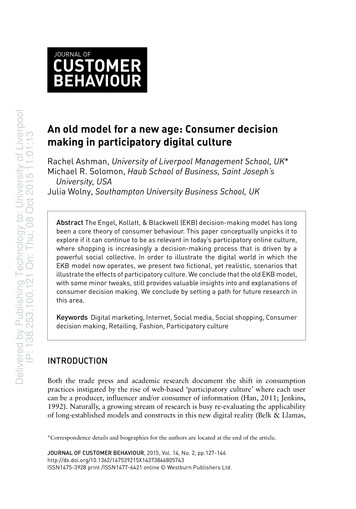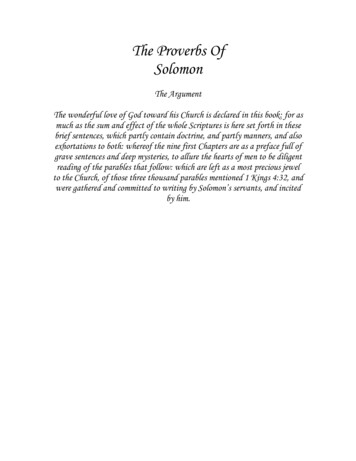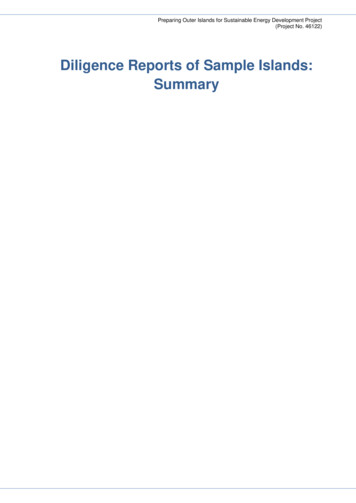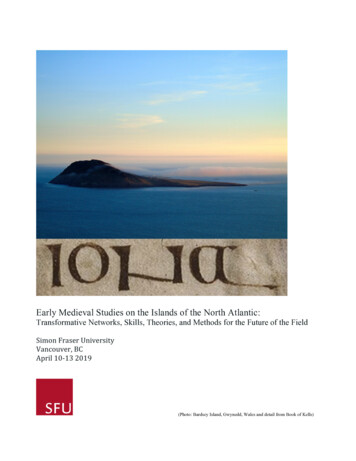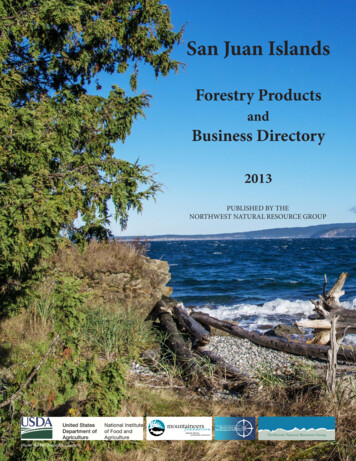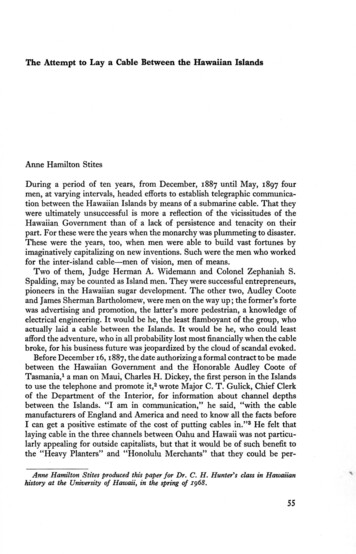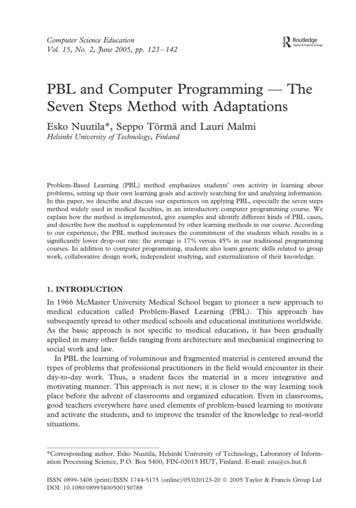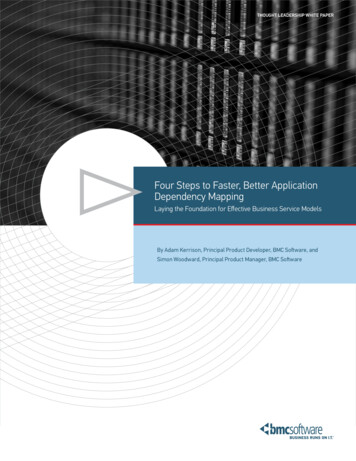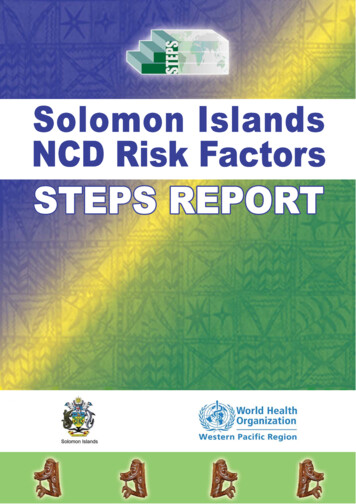
Transcription
Solomon IslandsNCD Risk FactorsSTEPS REPORTPrinted in Suva, FijiFebruary, 2010
AcknowledgementsThe Solomon Islands NCD Risk Factors STEPS REPORT (referred as “the Report”) is a record ofa combined effort of several organizations and individuals. We would like to acknowledge eachorganization and everyone’s contributions, dedication and determination in completing the surveyand finalizing the Report.The Report is a collaborative effort between the Solomon Islands Ministry of Health and MedicalServices (MHMS), World Health Organization and the Fiji School of Medicine (FSM).The Report was compiled by: Ms Nevalyn Laesango (MHMS), Dr Graham Roberts (FSM), Dr LiDan (WHO, Suva), Dr John Paulsen (MHMS), Ms Leanne Riley (WHO, Geneva), Mr Makiva Tuni(MHMS), Ms Josephine Watoto (MHMS), Mr Shalvindra Raj (WHO, Suva) and Dr Jan Pryor (USA).Appreciation is extended to the Hon. Minister for Health and Medical Services, Mr Clay ForauSoalaoi, the Permanent Secretary, Dr Lester Ross, and Undersecretary for Health Care, Dr CarlSusuairara for their leadership and support of the NCD STEPS work in Solomon Islands. A specialthank is made to the STEPS field survey staff (see Appendix 3 of the Report).Grateful acknowledgement is made to the World Health Organization and its staff, to Dr Chen Ken(WHO Representative in the South Pacific, Suva) for his great support, to Dr Han Tieru, Dr LindaMilan, Dr Cherian Varghese (WHO Office in Manila) for their support. Thanks are due to Dr JanPryor and Ms Shakila Naidu (UNICEF) as research consultants for this STEPS survey.We acknowledge the statistical support and result generation provided by Ms Leanne Riley, MsMelanie Cowan and Ms Regina Guthold (WHO Office in Geneva) and Mr Shalvindra Raj whomade substantial contribution to the completion of data analyses. Ms Taivuna Bulamaibau (WHOOffice in Suva), Ms Salome Ziku and Ms Corina Teika (WHO Office in Honiara) providedadministrative support to the finalization of the Report.The Solomon Islands STEPS survey and the Report were funded by the Australian Agency forInternational Development (AusAID), New Zealand Agency for International Development (NZAID)and WHO. The Ministry of Health and Medical Services, Solomon Islands provided in-kindcontribution.Dr Graham Roberts (FSM) drafted the first version of the Report, working closely with WHO Officein Suva. Ms Leanne Riley, Dr Li Dan, Mr Robert Hughes (Australia), Dr Cherian Varghese, MrShalvindra Raj and Ms Melanie Cowan have conducted technical reviews for the Report.The country consultation held in Honiara, Solomon Islands was attended by Dr Carl Susuairara(MHMS), Dr Tenneth Dalipanda (MHMS), Ms Nevalyn Laesango, Ms Yukako Toriyama (MHMS),Dr William Adu-Krow (WHO Office in Honiara) and Dr Li Dan.Dr Li Dan, Mr Robert Hughes and Dr Graham Roberts are the final technical and editorialreviewers of the Report.WHO Office in Suva arranged the printing, on behalf of the Solomon Islands Ministry of Health andMedical Services.2
CONTENTSFOREWORDEXECUTIVE TRODUCTIONBackground and RationaleThe National ContextGeographyPopulation and Living EnvironmentGovernment, Culture and the EconomyNoncommunicable Disease Health Status and HealthInfrastructureDeveloping WHO STEPS Survey in Solomon GYSurvey StructureSurvey Sampling MethodologyNational/Provincial Level SamplingWard/village level samplingHousehold level samplingSample SizeData Collection ProceduresData Collection ProcessRegistration of ParticipantsStep 1 - Behavioural Risk Factors InterviewsStep 2 - Physical MeasurementsStep 3 - Biochemical MeasurementsCheck-out Station and CounsellingData Management and AnalysesData EntryData Weighting and TSCharacteristics of Survey PopulationTobacco UseBetel Nut UseAlcohol ConsumptionIntake of Fruit and VegetablesPhysical ActivityQuestionsAnalysisLevels of Physical ActivityOverweight and ObesityHeight and WeightBody Mass Index CategoriesWaist 6
4.84.94.104.11Blood Pressure and HypertensionFasting Blood Glucose and DiabetesTotal CholesterolCombined Risk Factors464849505.DISCUSSION AND CONCLUSIONS526.RECOMMENDATIONS54APPENDICESAppendix 1Solomon Islands STEPS Survey QuestionnaireAppendix 2The Whole Data Book of the Solomon Islands STEPS SurveyList and Responsibilities of STEPS Survey Staff from SolomonAppendix 3IslandsAppendix 4ReferencesKEY CONTACTS4565766115117
LIST OF FIGURESFigure 1Figure 2The WHO STEPwise approach to surveillance of NCDsSequence of data collection and stations at the survey base1820LIST OF TABLESTable ATable BTable CTable DTable 1Table 2Table 3Table 4Table 5Table 6Table 7Table 8Table 9Table 10Table 11Table 12Table 13Table 14Table 15Table 16Table 17Table 18Table 19Table 20Table 21Table 22Table 23Solomon Islands NCD STEPS Survey: Province SamplesTotal Households (HH) in Honiara Province and sample selectedTotal Households (HH) in Western Province and sample selectedTotal Households (HH) in Malaita Province and sample selectedAge and Gender of study populationMean number of years of education by gender and age groupPercentage of current smokers in the study population by genderand age groupCurrent smoking status among men in the study population by agegroupCurrent smoking status among women in the study population byage groupCurrent smoking status among both sexes in the study population byage groupMean age started smoking among current daily smokersMean number of years of smoking among current daily smokersPercentage of current daily smokers who smoke manufacturedcigarettesPercentage of current betel nut chewers among men during the past12 months by age groupPercentage of current betel nut chewers among women during thepast 12 months by age groupPercentage of current betel nut chewers among both sexes duringthe past 12 months by age groupMean age started chewing betel nut among current daily chewersMean number of years of betel nut chewing among current dailychewersCurrent chewing status among men in the study population by agegroupCurrent chewing status among women in the study population byage groupCurrent chewing status among both sexes in the study population byage groupPercentage of alcohol consumption among men during the past 12months by age groupPercentage of alcohol consumption among women during the past12 months by age groupPercentage of alcohol consumption among both sexes during thepast 12 months by age groupFrequency and quantity of drinks consumed by male current drinkersin the last 7 daysFrequency and quantity of drinks consumed by female currentdrinkers in the last 7 daysNumber of drinks per drinking day among male current drinkers byage 3434353536
Table 24Table 25Table 26Table 27Table 28Table 29Table 30Table 31Table 32Table 33Table 34Table 35Table 36Table 37Table 38Table 39Table 40Table 41Table 42Table 43Table 44Table 45Table 46Table 47Table 48Table 49Table 50Table 51Table 52Table 53Table 54Table 55Table 56Number of drinks per drinking day among female current drinkers byage groupNumber of drinks per drinking day among both gender of currentdrinkers by age groupMean number of days in a week fruits consumed by gender and agegroupMean number of days in a week vegetables consumed by genderand age groupMean number of servings of fruits consumed on a day when fruitswere eatenMean number of servings of vegetables consumed on a day whenvegetables were eatenMean number of combined servings of fruit and vegetablesconsumed per average dayPercentage who consumed less than five combined servings of fruitand vegetables per average dayCategories of total physical activity among men by age groupCategories of total physical activity among women by age groupCategories of total physical activity among both sexes by age groupLevel of total physical activity (mean METminutes per day) bygender and age groupLevel of work-related physical activity (mean METminutes per day)by gender and age groupLevel of transport-related physical activity (mean METminutes perday) by gender and age groupLevel of recreation-related physical activity (mean METminutes perday) by gender and age groupMean height (cm) by gender and age groupMean weight (kg) by gender and age groupMean body mass index (kg/m2) by gender and age groupBMI classifications among men by age groupBMI classifications among women by age groupBMI classifications among both genders by age groupPercentage of obesity (BMI 30 kg/m2) by gender and age groupMean waist circumference (cm) by gender and age groupMean resting systolic blood pressure (mmHg) by gender and agegroupMean resting diastolic blood pressure (mmHg) by gender and agegroupPercentage with hypertension (SBP 140 and/or DBP 90 orcurrently on medication for raised blood pressure)Mean fasting blood glucose (mmol/L) by gender and age groupPrevalence of diabetes by gender and age groupMean total blood cholesterol (mmol/L) by gender and age groupPercentage with raised total blood cholesterol ( 5.0 mmol/L or 190mg/dl)Percentage of NCD risk categories among men by age groupPercentage of NCD risk categories among women by age groupPercentage of NCD risk categories among both genders by 5454647474748494950505151
LIST OF mol/LNCDPICsSBPWHOMHMSBody Mass IndexBlood PressureCoronary Heart DiseaseConfidence IntervalCardiovascular DiseaseDiastolic Blood PressureDiabetes MellitusFasting Blood SugarHypertensionMetabolic equivalentMilligrams per decilitre (unit of blood chemistry values)Millimetres of mercury (unit of blood pressure measurement)Millimoles per litre (unit for blood chemistry values)Noncommunicable diseasePacific island countries and areasSystolic Blood PressureWorld Health OrganizationMinistry of Health and Medical Services7
FOREWORDAlmost every country in the world has experienced a dramatic increase in chronic or lifestyle diseasesthat lead to death – attributable to change in lifestyles and the surrounding environment—referred tomany as noncommunicable diseases (NCDs). In order to address this growing problem effectively andefficiently, we must have accurate information regarding the risk factors that contribute to thedevelopment of NCDs. A “Risk factor” refers to any characteristic or exposure that increases aperson’s likelihood of developing a NCD. These risk factors include smoking, alcohol use, physicalinactivity, obesity, high blood pressure, a raised level of blood glucose or cholesterol, and anunbalanced diet. Each country needs to establish its capacity in order to conduct population risksurveillance over time for countries’ planning of program activities and services.We are pleased that the WHO has assisted the Solomon Islands to build our national capacity inpopulation risk factors survey and analysis. The findings suggest actions for implementation of policyin NCD control and prevention, supportive physical environment and infrastructure, and improvedhealth care services. The Solomon Islands NCD STEPS survey was specifically designed to assessthe prevalence of the common NCDs and risk factors in our population. The information from thissurvey provides an important platform for the development and implementation of strategic plans andprograms to address the growing epidemic of NCDs in Solomon Islands.This report is the result of the STEPS survey carried out in Solomon Islands in 2005-2006. It showshigh prevalence of NCDs and their risk factors among our population and suggests actions to: controland prevention NCDs; provide a supportive physical environment and infrastructure, and improvedhealth service delivery.This is the first population-based survey on the prevalence of the NCD risk affecting our population.It represents a milestone in our efforts to address the increasing NCD epidemic affecting our peopleand marks an increased commitment by the Ministry of Health and Medical Services to tackle theNCD challenge. The survey results and recommendations will enable us to develop more effectivehealth policies and programs in primary and secondary NCD prevention and in monitoring andevaluating our ongoing efforts in NCD prevention.8
The WHO STEPS survey in Solomon Islands would not have been possible without the vision andleadership of our predecessors. Their determination enabled this important survey to be givenpriority in Solomon Islands.Their determination in ensuring that Solomon Islands STEPS survey with WHO’s support has beenrealized. Last but certainly not the least, we would like to thank all the staff of this Ministry of Healthand Medical Services, partners like the Fiji School of Medicine for completing the first ever NCDpopulation survey in Solomon Islands, WHO for its strong technical support, and AusAID for financialsupport. This report is dedicated to the hard work and commitment evidenced from the inception to thecompletion of the NCD Risk Factors STEPS survey in Solomon Islands.We hope that the findings and recommendation in this report will guide our actions for improvinghealth for all.Mr Clay Forau SoalaoiMinister for Health and Medical ServicesSolomon IslandsDr Lester RossPermanent SecretaryMinistry of Health and Medical ServicesSolomon Islands9
The WHO STEPwise Approach to Surveillance of Risk Factors for NCDs (STEPS) is the WHOrecommended surveillance tool for chronic disease risk factors and chronic disease-specific morbidityand mortality at national level. To date, 120 countries and areas throughout the world utilize WHOSTEPS to conduct national surveys on risk factors of chronic disease and morbidity of NCDs. Thepublication of the “Solomon Islands NCD Risk Factors STEPS REPORT” marks a milestone as i
Office in Suva), Ms Salome Ziku and Ms Corina Teika (WHO Office in Honiara) provided administrative support to the finalization of the Report. The Solomon Islands STEPS survey and the Report were funded by the Australian Agency for International Development (AusAID), New Zealand Agency for International Development (NZAID) and WHO. The Ministry of Health and Medical Services, Solomon Islands .

